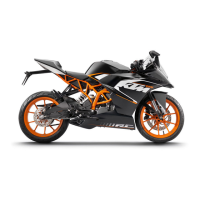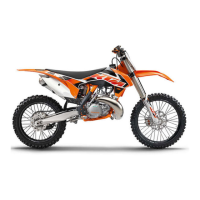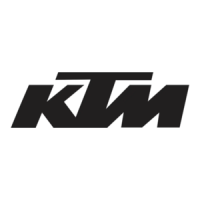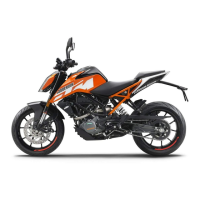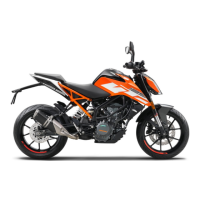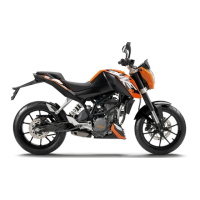Why KTM 125 Duke EU 2015 engine turns only if the clutch lever is drawn?
- CChristine ContrerasSep 9, 2025
If your KTM Motorcycle engine only turns when the clutch lever is drawn, the vehicle is likely in gear. Shift the gear to neutral.
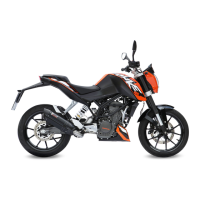
Why KTM 125 Duke EU 2015 engine turns only if the clutch lever is drawn?
If your KTM Motorcycle engine only turns when the clutch lever is drawn, the vehicle is likely in gear. Shift the gear to neutral.
What causes high oil consumption in my KTM 125 Duke EU 2015 Motorcycle?
If your KTM Motorcycle has high oil consumption, it could be due to a bent engine vent hose. Route the vent hose without bends or replace it if necessary. It may also be because the engine oil level is too high, so check the engine oil level. Another reason might be that the engine oil is too thin (low viscosity), so change the engine oil and oil filter, and clean the oil screen.
Why is the time not correctly displayed on my KTM 125 Duke EU 2015?
If the time is not correctly displayed on your KTM Motorcycle, it could be due to a blown fuse 2 (without ABS) or fuse 8 (with ABS). Replace the fuse and set the clock.
Why is the speedometer in the combination instrument not functioning on my KTM 125 Duke EU 2015 Motorcycle?
If the speedometer in the combination instrument of your KTM Motorcycle is not functioning, the speedometer wiring harness may be damaged, or the plug-in connection may be oxidized. Check the wiring harness and plug-in connection.
What causes the battery to discharge on my KTM 125 Duke EU 2015?
If the battery of your KTM Motorcycle is discharged, it could be because the ignition was not switched off when the vehicle was parked. Recharge the battery. It might also be that the battery is not being charged by the alternator, so check the charging voltage and the open-circuit current.
| Displacement | 124.7 cc |
|---|---|
| Bore x Stroke | 58 mm x 47.2 mm |
| Transmission | 6-speed |
| Fuel System | Electronic Fuel Injection |
| Rear Brake | 230 mm disc, single-piston caliper |
| ABS | Optional |
| Front Tire | 110/70-17 |
| Rear Tire | 150/60-17 |
| Seat Height | 810 mm |
| Starter | Electric starter |
| Engine Type | Single-cylinder, 4-stroke |
| Power | 11 kW (15 hp) @ 9, 500 rpm |
| Torque | 12 Nm @ 8, 000 rpm |
| Frame | Steel trellis |
| Front Suspension | WP upside-down fork |
| Rear Suspension | Monoshock |
| Front Brake | 300 mm disc |
| Fuel Tank Capacity | 11 liters |
| Cooling system | Liquid-cooled |
Emphasizes reading the manual for safety instructions and keeping warning labels on the vehicle.
Explains danger levels (Danger, Warning, Caution, Note) and their associated symbols.
Prohibits tampering with the noise control system and lists presumed acts of tampering.
Provides advice on safe operation, including avoiding impairment, ensuring ventilation, and handling hot components.
Recommends wearing protective clothing (helmet, boots, gloves, etc.) for increased safety.
Outlines rules for assembly, use of special tools, and checking parts after repair.
Stresses the importance of reading the manual before the first trip and keeping it accessible.
Highlights that proper service and tuning are crucial for optimal operation and preventing wear.
Shows a diagram illustrating the front-left view of the motorcycle with numbered components.
Describes the location and function of the clutch lever on the left handlebar.
Describes the location and function of the hand brake lever on the right handlebar.
Describes the location and function of the throttle grip on the right handlebar.
Explains the function of the light switch for low beam and high beam.
Explains the function of the emergency OFF switch to interrupt the ignition circuit.
Describes the location and operation of the electric starter button.
Explains the positions of the ignition lock and steering lock.
Details the instrument cluster: overview, activation, warnings, display modes, indicator lamps, and data menus.
Provides essential advice and warnings for the first use of the vehicle, including safety and handling.
Details the procedure and recommendations for engine running-in, including speed limits.
Warns about unstable handling due to improper loading and exceeding weight limits.
Lists essential checks (oil, brakes, tires, etc.) to ensure roadworthiness before every trip.
Details the safe procedure for starting the motorcycle's engine, including safety warnings.
Explains how to start moving from a standstill, including clutch and throttle control.
Provides guidance on shifting gears, riding defensively, and adapting speed to conditions.
Explains proper braking techniques, warnings about ABS, and stopping distances.
Details how to safely stop, park the motorcycle, secure it, and warnings about hot components.
Details the procedure for refueling the motorcycle with safety warnings about fuel hazards.
Lists recommended maintenance tasks and their intervals (1,000 km, 7,500 km, 15,000 km, and 4 years).
Explains how to check the drive chain tension and its importance for drivetrain.
Details the procedure for adjusting the drive chain tension for proper alignment.
Explains how to check wear on the chain and sprockets, recommending simultaneous replacement.
Explains the ABS system, its function, limitations, and safety aspects.
Details checking tires for damage, tread depth, age, and correct tread patterns.
Explains how to check and set the correct tire air pressure for solo and passenger loads.
Details how to check coolant antifreeze and level, with safety warnings about hot coolant.
Explains how to check coolant levels in the compensating tank and radiator.
Explains how to correctly check the engine oil level when the engine is at operating temperature.
Details the process for changing engine oil and filter, including cleaning the oil screen.
Provides instructions for adding engine oil, including recommended types and quantities.
Lists possible causes and actions for the engine not cranking.
Lists possible causes and actions for the engine failing to start.
Lists possible causes and actions for reduced engine power.
Lists possible causes and actions for the engine overheating.
Lists possible causes and actions for the engine stopping during a trip.
Lists possible causes and actions for a discharged battery.
Lists possible causes and actions for a blank instrument cluster display.
Provides detailed engine specifications for the 125 Duke and 200 Duke models.

